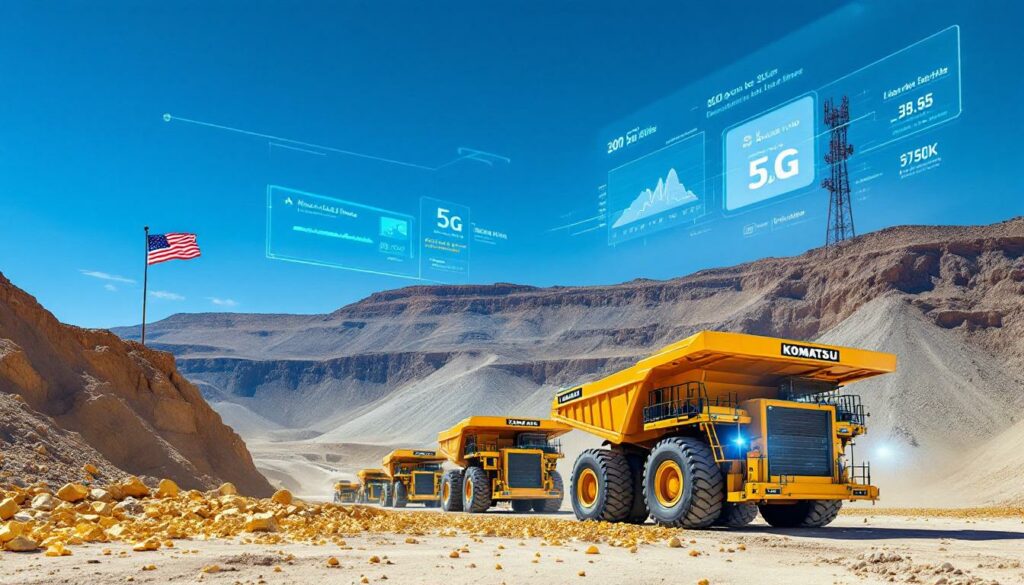Revolutionizing Mining Operations: Nevada Gold Mines and Komatsu's Autonomous Haulage Partnership
In a groundbreaking development for the U.S. mining industry, Nevada Gold Mines (NGM) and Komatsu have launched a transformative partnership to implement autonomous haulage across NGM's surface operations. This collaboration marks the first implementation of Komatsu's FrontRunner Autonomous Haulage System (AHS) in the United States, setting a new benchmark for mining safety and efficiency in North America.
The Groundbreaking Collaboration
The partnership between Nevada Gold Mines and Komatsu represents a significant step forward in mining industry innovation. NGM's extensive fleet of 300-ton and 230-ton haul trucks will be converted to operate autonomously using Komatsu's FrontRunner system, enabling unmanned operation across the company's expansive surface mining operations.
Mark Bristow, Barrick president and CEO, emphasized the significance of this initiative: "This is a strong example of how proven global solutions can be adapted to meet NGM's specific operational needs. Barrick and NGM are committed to innovation that drives meaningful change. But more than that, it's about protecting our people."
The implementation began with a successful live demonstration at NGM's Cortez operations, showcasing the system's capabilities and setting the stage for full-scale deployment. This partnership not only represents a technological leap but also demonstrates NGM's commitment to leveraging advanced technologies to enhance safety and operational efficiency.
Key Technology Components
At the heart of this autonomous mining revolution is Komatsu's FrontRunner Autonomous Haulage System, a sophisticated technology stack that enables haul trucks to operate without onboard drivers. The system integrates advanced GPS positioning, obstacle detection sensors, and precision control algorithms to navigate mining environments safely and efficiently.
A critical enabler of this autonomous system is the customized 5G communications infrastructure deployed by Sedna and Nokia. This high-performance network provides the essential connectivity backbone required for autonomous operations, delivering the high-speed, low-latency data transmission necessary for real-time equipment control and monitoring.
Peter Dormehl, Sedna CEO, highlighted the importance of this communications infrastructure: "This collaboration demonstrates how technology leaders can come together to create powerful, future-ready solutions. The 5G network will provide the robust foundation needed to support high-performance, safety-critical operations."
The system features redundant communication pathways and fail-safe protocols to ensure operational continuity and safety. Real-time data exchange between vehicles and the control center enables immediate response to changing conditions, while comprehensive telemetry data allows for continuous system optimization and predictive maintenance.
Why Are Mining Companies Investing in Autonomous Haulage?
Safety Enhancement Benefits
The primary driver behind the adoption of autonomous haulage systems is the significant improvement in operational safety. By removing operators from haul trucks, mining companies substantially reduce human exposure to high-risk environments, including steep haul roads, unstable ground conditions, and areas with potential rock falls.
Autonomous systems eliminate human factors such as fatigue, distraction, and judgment errors that can contribute to accidents. The FrontRunner system operates with consistent precision, maintaining optimal speeds, following designated routes, and adhering to safety protocols without variation.
The technology also incorporates sophisticated obstacle detection and collision avoidance capabilities, using multiple sensor systems to identify potential hazards and take appropriate action. These systems can detect objects and conditions that might be missed by human operators, particularly during adverse weather or low-visibility situations.
Predictive maintenance capabilities further enhance safety by identifying potential equipment failures before they occur. By monitoring hundreds of performance parameters in real-time, the system can detect anomalies and schedule maintenance interventions before components reach critical failure points.
Operational Efficiency Improvements
Beyond safety enhancements, autonomous haulage delivers substantial operational benefits that contribute directly to mining economics. The FrontRunner system enables more consistent and predictable fleet performance, optimizing cycle times and reducing variability in production metrics.
Autonomous trucks operate continuously without shift changes, meal breaks, or operator fatigue factors. This continuous operation can increase effective production hours by 10-15% compared to manually operated fleets, depending on the operation.
Fuel consumption typically improves with autonomous operation, as the system maintains optimal acceleration, speed, and braking patterns. Consistent operation also reduces wear and tear on mechanical components, potentially extending equipment lifespan and reducing maintenance costs.
The precision of autonomous navigation ensures optimal positioning at loading and dumping points, reducing waiting times and improving overall cycle efficiency. This precision also minimizes damage to equipment and infrastructure from positioning errors.
"The FrontRunner system significantly minimises employee exposure to potential hazards, while enhancing more predictable fleet performance, better fuel consumption and continuous operations — all of which contribute to a safer, more sustainable future for mining," noted Mark Bristow, highlighting the dual benefits of safety and efficiency gains.
How Does 5G Technology Enable Autonomous Mining Operations?
The Critical Communications Infrastructure
The success of autonomous mining operations hinges on reliable, high-performance communications infrastructure. The customized 5G network deployed by Sedna and Nokia at NGM's operations provides the essential connectivity backbone that makes autonomous haulage possible in challenging mining environments.
Mining operations present unique challenges for communications networks, including vast operating areas, dynamic topography, dust, vibration, and electromagnetic interference from equipment. The 5G network implemented at NGM has been specifically engineered to overcome these challenges, providing consistent coverage across operational areas.
The network delivers ultra-low latency communications—critical for real-time control of autonomous equipment. While standard communications might be adequate for monitoring, the millisecond-level response times required for safety-critical control functions demand the performance capabilities of 5G technology.
Bandwidth capabilities support the massive data flows generated by autonomous operations, including:
- High-definition video feeds from multiple cameras on each vehicle
- Telemetry data from hundreds of sensors per vehicle
- Precise positioning information updated multiple times per second
- Environmental monitoring data from across the operation
- Control signals to multiple vehicles simultaneously
Redundancy is built into every level of the communications system, with multiple transmission paths, backup power systems, and fail-safe protocols ensuring operations can continue safely even if parts of the network experience disruption.
Future-Ready Mining Communications
The 5G infrastructure implemented at NGM creates a foundation for future technological advancement beyond autonomous haulage. Don Leyn, director of sales and mining at Nokia, emphasized this forward-looking approach: "Together, we are building more than just connectivity, we're creating a network solution built for the future and for today."
This communications platform enables the integration of additional autonomous systems, including drilling, blasting, and auxiliary equipment. The scalable nature of the 5G network allows for expanding capacity and coverage as operations evolve and new technologies are implemented.
Advanced data management capabilities facilitate real-time analytics and machine learning applications that can continuously optimize fleet performance. By analyzing patterns in operational data, these systems can identify efficiency opportunities that might not be apparent through conventional analysis.
The network incorporates sophisticated cybersecurity measures to protect autonomous operations from potential threats. Multi-layered security protocols, encryption, and continuous monitoring safeguard both operational technology (OT) and information technology (IT) systems from unauthorized access or interference.
Who Are the Key Players in This Mining Automation Initiative?
Nevada Gold Mines' Strategic Vision
Nevada Gold Mines, a joint venture between Barrick Gold Corporation (61.5%) and Newmont Corporation (38.5%), stands as the single largest gold-producing complex in the world. The company operates multiple mines across Nevada, employing thousands of workers and producing millions of ounces of gold annually.
NGM's investment in autonomous technology reflects its strategic commitment to innovation and operational excellence. The company views automation not as simply a cost-cutting measure but as a fundamental transformation of its operating model that enhances safety, sustainability, and long-term viability.
Mark Bristow, who leads Barrick as president and CEO, has consistently championed technological innovation as essential to the future of mining. Under his leadership, Barrick has pursued a strategy of implementing proven technologies in ways that address specific operational challenges while delivering measurable benefits.
NGM's approach to automation exemplifies the company's broader commitment to responsible mining practices. By reducing human exposure to hazards, optimizing resource utilization, and improving environmental performance, the autonomous haulage initiative aligns with NGM's sustainability objectives and community commitments.
Technology Partners and Their Contributions
This ambitious automation initiative brings together several technology leaders, each contributing specialized expertise:
Komatsu brings decades of experience in autonomous mining equipment, having deployed its FrontRunner system at operations around the world. Braden Weisheit, General Manager of Mining Technology Solutions at Komatsu, noted: "We're proud to partner with Nevada Gold Mines on this transformative initiative. The scale and ambition of this deployment mark a major milestone for autonomous mining in America."
Sedna provides specialized expertise in mining communications infrastructure, with a focus on delivering reliable connectivity in challenging environments. As a systems integrator, Sedna plays a crucial role in ensuring that the various technological components work together seamlessly.
Nokia contributes its industrial-grade 5G technology, adapted specifically for the mining environment. The company's experience in deploying mission-critical communications networks in various industries provides valuable insights for the mining application.
The collaboration between these partners demonstrates the importance of an ecosystem approach to mining automation. No single company possesses all the expertise required for such a complex technological implementation, making partnership essential for successful deployment.
What Does the Implementation Process Look Like?
Deployment Strategy and Timeline
Implementing autonomous haulage across NGM's operations requires a carefully planned, phased approach. The initiative began with a successful live demonstration at NGM's Cortez operations, establishing proof of concept and validating the technology in the specific operating environment.
The implementation follows a carefully structured deployment sequence:
- Site assessment and preparation: Detailed mapping of haul routes, identification of potential hazards, and infrastructure preparation
- Communications infrastructure deployment: Installation and testing of the 5G network across operational areas
- Fleet conversion: Systematic retrofitting of haul trucks with autonomous control systems
- Controlled testing: Validation of system performance in isolated operational areas
- Graduated deployment: Expansion of autonomous operations across sites in carefully managed phases
- Full operational integration: Complete integration with mine planning and production systems
Throughout this process, rigorous testing and validation protocols ensure that each system component meets performance and safety requirements before advancing to the next implementation phase. This methodical approach minimizes operational disruption while maintaining safety standards.
Change Management Considerations
The transition to autonomous operations represents a significant change for NGM's workforce and operational practices. Effective change management is critical to successful implementation, focusing on workforce transition, operational adaptation, and cultural alignment.
Comprehensive training programs prepare employees for new roles in autonomous operations, including:
- Autonomous system monitoring and supervision
- Remote operations center management
- Fleet optimization and routing
- System maintenance and troubleshooting
- Emergency response protocols
The implementation creates new career opportunities for existing employees, allowing truck operators to transition to higher-skilled technical and supervisory positions. These roles typically offer improved working conditions, reduced physical demands, and opportunities for professional advancement.
Maintenance protocols must evolve to support autonomous equipment, with greater emphasis on sensor systems, communications components, and electronic controls. Maintenance teams require specialized training on these systems, along with new diagnostic tools and procedures.
Extensive data collection and performance monitoring systems track key metrics throughout the implementation process, enabling continuous improvement and optimization. This data-driven mining operations approach ensures that the benefits of autonomous operation are fully realized while identifying opportunities for further enhancement.
How Will This Partnership Impact the Mining Industry?
Setting New Industry Standards
The NGM-Komatsu partnership represents a watershed moment for mining automation in North America, establishing new benchmarks for scale and ambition. As the first implementation of its kind in the United States, this initiative will provide valuable insights and operational data that will influence future automation projects across the industry.
The successful deployment of autonomous haulage at NGM will likely accelerate the adoption timeline for similar technologies at other North American mining operations. Companies that have been monitoring automation developments will gain confidence from NGM's example, potentially compressing industry-wide implementation timelines.
This project will contribute to the development of regulatory frameworks and compliance standards for autonomous mining in the United States. Regulatory agencies will closely observe the implementation, using insights from NGM's experience to inform guidelines that balance innovation with safety requirements.
Industry-wide safety implications extend beyond NGM's operations, as successful demonstration of safety improvements will establish new expectations for acceptable risk levels in mining. This "raising of the bar" effect could drive safety improvements even at operations that don't immediately adopt autonomous technology.
Economic and Environmental Implications
The economic impact of autonomous haulage extends beyond direct operational costs. While the initial capital investment is substantial, the long-term economic benefits include reduced operating costs, improved equipment utilization, and potential increases in recoverable reserves due to lower cutoff grades made possible by improved operational economics.
Environmental benefits arise from multiple aspects of autonomous operation:
- Optimized fuel consumption through consistent operation and efficient routing, reducing carbon emissions per ton of material moved
- Precise adherence to designated routes, minimizing unnecessary travel and reducing the operational footprint
- Reduced dust generation through consistent speed control and optimized acceleration/deceleration
- Extended equipment lifecycle through reduced mechanical stress, decreasing the environmental impact of manufacturing replacement equipment
The sustainability improvements from resource optimization contribute to NGM's environmental goals while potentially improving community relations through demonstrated commitment to responsible resource development.
"All of which contribute to a safer, more sustainable future for mining," Mark Bristow emphasized, highlighting how operational improvements translate to environmental benefits.
What Are the Future Possibilities for Mining Automation?
Next-Generation Mining Technologies
The autonomous haulage partnership opens pathways to broader automation across mining operations. Future developments could include:
Integrated autonomous systems that coordinate haulage with drilling, loading, and auxiliary equipment. This systems approach would optimize the entire mining process rather than individual components, creating substantial efficiency gains.
Artificial intelligence applications could move beyond current rule-based automation to true machine learning systems that continuously improve operational performance. These AI in mining operations could identify complex patterns and optimization opportunities invisible to human analysts.
Remote operations centers could eventually manage multiple mine sites from centralized locations, allowing expertise to be leveraged across operations. These centers would reduce the need for personnel at remote mine sites while improving access to specialized technical support.
Digital twin modeling would create virtual replicas of physical operations, enabling sophisticated scenario planning and optimization. These models would allow operators to test operational changes virtually before implementation, reducing risk and improving outcomes.
Expanding Beyond Haulage
While autonomous haulage represents a significant advancement, it's only one element of the fully autonomous mine of the future. The technology and infrastructure established through this partnership creates a foundation for expansion into other operational areas:
Autonomous drilling systems could improve drilling accuracy, pattern compliance, and utilization rates while removing operators from hazardous areas near highwalls and under unstable ground conditions.
Automated blasting operations could enhance fragmentation consistency while improving safety through reduced personnel exposure during explosive loading and initiation.
Autonomous ground engagement tools such as dozers and graders could maintain haul roads and manage waste dumps with greater precision and consistency than manual operation.
End-to-end digital supply chain management would integrate autonomous operations with processing facilities, logistics systems, and market delivery, creating a seamless digital thread from resource to customer.
The long-term vision points toward mining operations with significantly reduced on-site personnel requirements, particularly for hazardous or remote locations. This transition would reshape mining economics while addressing persistent industry challenges in workforce recruitment and retention.
FAQ: Nevada Gold Mines' Autonomous Haulage System
What specific safety improvements does autonomous haulage provide?
Autonomous haulage systems deliver multiple safety benefits:
- Elimination of operator fatigue factors that contribute to accidents, particularly during night shifts or extended operations
- Consistent adherence to safety protocols without the variability of human judgment or occasional procedural shortcuts
- Reduced personnel exposure in hazardous areas such as pit edges, dump points, and loading zones
- Advanced collision avoidance capabilities using multiple sensor systems that function effectively in all visibility conditions
- Precise navigation that maintains safe distances from highwalls, berms, and other vehicles at all times
These systems also eliminate risks associated with operator access and egress from large equipment, which is a common source of injuries in mining operations.
How does the system handle unexpected situations?
Autonomous haulage systems incorporate sophisticated capabilities for handling unexpected events:
- Multi-layered sensor systems including radar, LiDAR, cameras, and proximity detection provide redundant detection of obstacles or hazards
- Progressive response protocols apply appropriate actions based on threat level, from speed reduction to complete stops
- Human oversight through operations center monitoring allows for intervention when needed
- Machine learning improvements enable the system to handle increasingly complex situations as operational experience grows
When confronted with situations beyond its decision parameters, the system defaults to the safest possible state—typically a controlled stop—and alerts human supervisors for intervention.
What happens to the current truck operators?
The transition to autonomous haulage creates new career opportunities for existing operators:
- Transition to supervisory roles monitoring and managing autonomous fleets from control centers
- Retraining programs for technical positions maintaining and supporting autonomous systems
- New positions in autonomous operations centers requiring specialized skills
- Skills development preparing employees for the increasingly technical mining environment
Mining companies implementing autonomous systems typically commit to retaining skilled workers through retraining programs. The transition often improves working conditions by moving personnel from isolated cab environments to collaborative control centers with regular schedules and reduced physical demands.
How does autonomous haulage impact mining economics?
The economic impact of autonomous haulage stems from multiple factors:
- Capital expenditure considerations include initial system costs and infrastructure requirements, representing significant investment
- Operational savings derive from reduced labor costs
Ready to Stay Ahead of Major Mineral Discoveries?
Gain instant notifications on significant ASX mineral discoveries with Discovery Alert's proprietary Discovery IQ model, turning complex mining data into actionable insights for your investment decisions. Begin your 30-day free trial today and position yourself ahead of the market.




